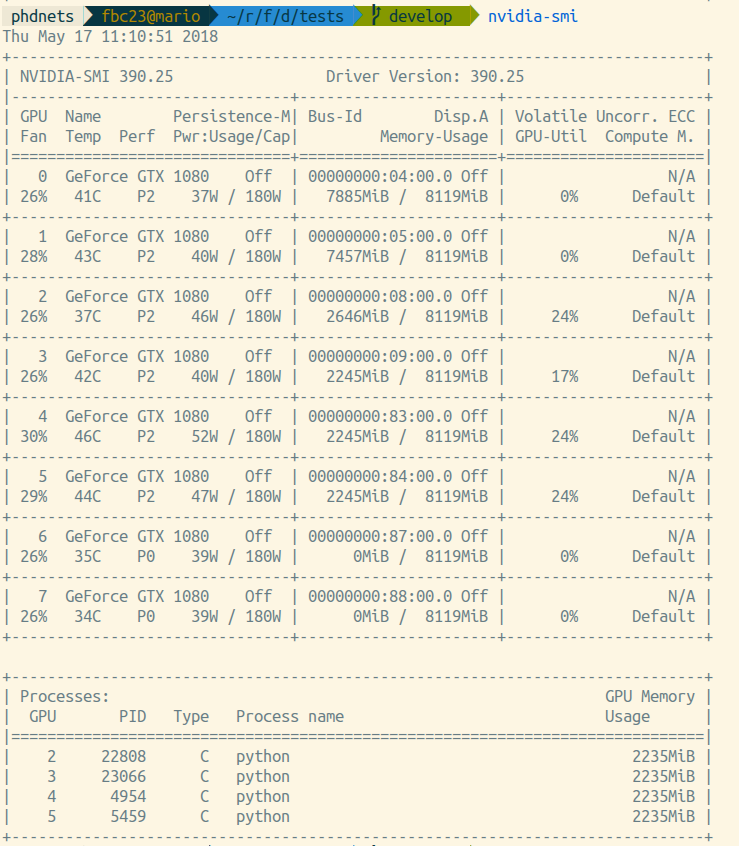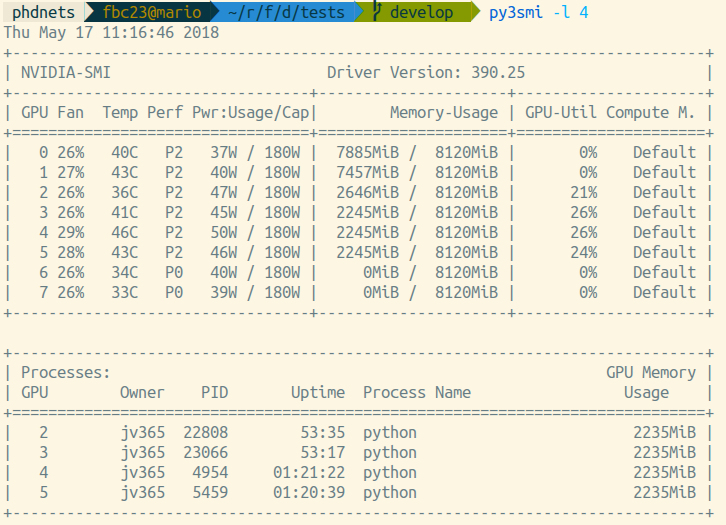Python 3 Bindings for the NVIDIA Management Library
Project description
Python 3 compatible bindings to the NVIDIA Management Library. Can be used to query the state of the GPUs on your system. This was ported from the NVIDIA provided python bindings nvidia-ml-py, which only supported python 2. I have forked from version 7.352.0. The old library was itself a wrapper around the NVIDIA Management Library.
In addition to these NVIDIA functions to query the state of the GPU, I have written a couple functions/tools to help in using gpus (particularly for a shared gpu server). These are:
A function to ‘restrict’ the available GPUs by setting the CUDA_VISIBLE_DEVICES environment variable.
A script for displaying a differently formatted nvidia-smi.
See the Utils section below for more info.
Requires
Python 3.5+.
Installation
From PyPi:
$ pip install py3nvml
From GitHub:
$ pip install -e git+https://github.com/fbcotter/py3nvml#egg=py3nvml
Or, download and pip install:
$ git clone https://github.com/fbcotter/py3nvml $ cd py3nvml $ pip install .
Utils
(Added by me - not ported from NVIDIA library)
grab_gpus
You can call the grab_gpus(num_gpus, gpu_select, gpu_fraction=.95) function to check the available gpus and set
the CUDA_VISIBLE_DEVICES environment variable as need be. It determines if a GPU is available by checking if the
amount of free memory is below memory-usage is above/equal to the gpu_fraction value. The default of .95 allows for some
small amount of memory to be taken before it deems the gpu as being ‘used’.
I have found this useful as I have a shared gpu server and like to use tensorflow which is very greedy and calls to
tf.Session() grabs all available gpus.
E.g.
import py3nvml
import tensorflow as tf
py3nvml.grab_gpus(3)
sess = tf.Session() # now we only grab 3 gpus!Or the following will grab 2 gpus from the first 4 (and leave any higher gpus untouched)
py3nvml.grab_gpus(num_gpus=2, gpu_select=[0,1,2,3])
sess = tf.Session()This will look for 3 available gpus in the range of gpus from 0 to 3. The range option is not necessary, and it only serves to restrict the search space for the grab_gpus.
You can adjust the memory threshold for determining if a GPU is free/used with the gpu_fraction parameter
(default is 1):
# Will allocate a GPU if less than 20% of its memory is being used
py3nvml.grab_gpus(num_gpus=2, gpu_fraction=0.8)
sess = tf.Session()This function has no return codes but may raise some warnings/exceptions:
If the method could not connect to any NVIDIA gpus, it will raise a RuntimeWarning.
If it could connect to the GPUs, but there were none available, it will raise a ValueError.
If it could connect to the GPUs but not enough were available (i.e. more than 1 was requested), it will take everything it can and raise a RuntimeWarning.
get_free_gpus
This tool can query the gpu status. Unlike the default for grab_gpus, which checks the memory usage of a gpu, this function checks if a process is running on a gpu. For a system with N gpus, returns a list of N booleans, where the nth value is True if no process was found running on gpu n. An example use is:
import py3nvml
free_gpus = py3nvml.get_free_gpus()
if True not in free_gpus:
print('No free gpus found')py3smi
I found the default nvidia-smi output was missing some useful info, so made use of the py3nvml/nvidia_smi.py module to query the device and get info on the GPUs, and then defined my own printout. I have included this as a script in scripts/py3smi. The print code is horribly messy but the query code is very simple and should be understandable.
Running pip install will now put this script in your python’s bin, and you’ll be able to run it from the command line. Here is a comparison of the two outputs:


For py3smi, you can specify an update period so it will refresh the feed every
few seconds. I.e., similar to watch -n5 nvidia-smi, you can run
py3smi -l 5.
You can also get the full output (very similar to nvidia-smi) by running py3smi -f (this shows a slightly modified process info pane below).
Regular Usage
Visit NVML reference for a list of the functions available and their help. Also the script py3smi is a bit hacky but shows examples of me querying the GPUs for info.
(below here is everything ported from pynvml)
from py3nvml.py3nvml import *
nvmlInit()
print("Driver Version: {}".format(nvmlSystemGetDriverVersion()))
# e.g. will print:
# Driver Version: 352.00
deviceCount = nvmlDeviceGetCount()
for i in range(deviceCount):
handle = nvmlDeviceGetHandleByIndex(i)
print("Device {}: {}".format(i, nvmlDeviceGetName(handle)))
# e.g. will print:
# Device 0 : Tesla K40c
# Device 1 : Tesla K40c
nvmlShutdown()Additionally, see py3nvml.nvidia_smi.py. This does the equivalent of the nvidia-smi command:
nvidia-smi -q -x
With
import py3nvml.nvidia_smi as smi
print(smi.XmlDeviceQuery())Differences from NVML
The py3nvml library consists of python methods which wrap several NVML functions, implemented in a C shared library. Each function’s use is the same with the following exceptions:
Instead of returning error codes, failing error codes are raised as Python exceptions. I.e. They should be wrapped with exception handlers.
try: nvmlDeviceGetCount() except NVMLError as error: print(error)
C function output parameters are returned from the corresponding Python function as tuples, rather than requiring pointers. Eg the C function:
nvmlReturn_t nvmlDeviceGetEccMode(nvmlDevice_t device, nvmlEnableState_t *current, nvmlEnableState_t *pending);Becomes
nvmlInit() handle = nvmlDeviceGetHandleByIndex(0) (current, pending) = nvmlDeviceGetEccMode(handle)
C structs are converted into Python classes. E.g. the C struct:
nvmlReturn_t DECLDIR nvmlDeviceGetMemoryInfo(nvmlDevice_t device, nvmlMemory_t *memory); typedef struct nvmlMemory_st { unsigned long long total; unsigned long long free; unsigned long long used; } nvmlMemory_t;Becomes:
info = nvmlDeviceGetMemoryInfo(handle) print("Total memory: {}MiB".format(info.total >> 20)) # will print: # Total memory: 5375MiB print("Free memory: {}".format(info.free >> 20)) # will print: # Free memory: 5319MiB print("Used memory: ".format(info.used >> 20)) # will print: # Used memory: 55MiB
Python handles string buffer creation. E.g. the C function:
nvmlReturn_t nvmlSystemGetDriverVersion(char* version, unsigned int length);Can be called like so:
version = nvmlSystemGetDriverVersion() nvmlShutdown()
5. All meaningful NVML constants and enums are exposed in Python. E.g. the constant NVML_TEMPERATURE_GPU is available under py3nvml.NVML_TEMPERATURE_GPU
The NVML_VALUE_NOT_AVAILABLE constant is not used. Instead None is mapped to the field.
Release Notes (for pynvml)
Version 2.285.0
Added new functions for NVML 2.285. See NVML documentation for more information.
Ported to support Python 3.0 and Python 2.0 syntax.
Added nvidia_smi.py tool as a sample app.
Version 3.295.0
Added new functions for NVML 3.295. See NVML documentation for more information.
Updated nvidia_smi.py tool - Includes additional error handling
Version 4.304.0
Added new functions for NVML 4.304. See NVML documentation for more information.
Updated nvidia_smi.py tool
Version 4.304.3
Fixing nvmlUnitGetDeviceCount bug
Version 5.319.0
Added new functions for NVML 5.319. See NVML documentation for more information.
Version 6.340.0
Added new functions for NVML 6.340. See NVML documentation for more information.
Version 7.346.0
Added new functions for NVML 7.346. See NVML documentation for more information.
Version 7.352.0
Added new functions for NVML 7.352. See NVML documentation for more information.
COPYRIGHT
Copyright (c) 2011-2015, NVIDIA Corporation. All rights reserved.
LICENSE
Redistribution and use in source and binary forms, with or without modification, are permitted provided that the following conditions are met:
Redistributions of source code must retain the above copyright notice, this list of conditions and the following disclaimer.
Redistributions in binary form must reproduce the above copyright notice, this list of conditions and the following disclaimer in the documentation and/or other materials provided with the distribution.
Neither the name of the NVIDIA Corporation nor the names of its contributors may be used to endorse or promote products derived from this software without specific prior written permission.
THIS SOFTWARE IS PROVIDED BY THE COPYRIGHT HOLDERS AND CONTRIBUTORS “AS IS” AND ANY EXPRESS OR IMPLIED WARRANTIES, INCLUDING, BUT NOT LIMITED TO, THE IMPLIED WARRANTIES OF MERCHANTABILITY AND FITNESS FOR A PARTICULAR PURPOSE ARE DISCLAIMED. IN NO EVENT SHALL THE COPYRIGHT HOLDER OR CONTRIBUTORS BE LIABLE FOR ANY DIRECT, INDIRECT, INCIDENTAL, SPECIAL, EXEMPLARY, OR CONSEQUENTIAL DAMAGES (INCLUDING, BUT NOT LIMITED TO, PROCUREMENT OF SUBSTITUTE GOODS OR SERVICES; LOSS OF USE, DATA, OR PROFITS; OR BUSINESS INTERRUPTION) HOWEVER CAUSED AND ON ANY THEORY OF LIABILITY, WHETHER IN CONTRACT, STRICT LIABILITY, OR TORT (INCLUDING NEGLIGENCE OR OTHERWISE) ARISING IN ANY WAY OUT OF THE USE OF THIS SOFTWARE, EVEN IF ADVISED OF THE POSSIBILITY OF SUCH DAMAGE.
Project details
Release history Release notifications | RSS feed
Download files
Download the file for your platform. If you're not sure which to choose, learn more about installing packages.
Source Distribution
Built Distribution
Hashes for py3nvml-0.2.2-py2.py3-none-any.whl
| Algorithm | Hash digest | |
|---|---|---|
| SHA256 | 7205a393d6b848b9e4cb117a9b15a019d889dafa7bee0b6b1d9dab1e47b3d6a5 |
|
| MD5 | c6f6704960a077f0e1d9bbc35cd060b7 |
|
| BLAKE2b-256 | f19f2bd9bb548ca2e1c125a3de38a15b9c6870ef42f3003679c367562e275626 |











